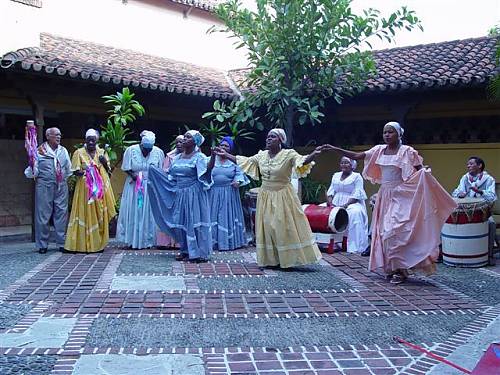get these nets
Veteran
*segment is from beginning to 8:08
Tumba Francesa performances generally open with a solo in Spanish or French patois by a lead singer, the composé. Following the composé’s cue, the catá, a large wooden idiophone, bursts into a pulsating beat enhanced by three drums known as tumbas. These hand-played instruments, similar to modern conga drums, are crafted from a single piece of hollowed wood and decorated with carved and painted motifs. The dances are performed under the direction of the Mayor de Plaza. The predominately female chorus singers and dancers wear long colonial-era dresses with West African kerchiefs and brandish colourful scarves. The singers keep rhythm with metal rattles or chachás. Performances consisting of a series of 30- minute songs and dances generally last well into the night.
Today, only two of the many dance styles associated with Tumba Francesa are still regularly performed: the masón, a light parody of French ballroom dances; and the yubá, an improvised dance accompanied by rousing drum rhythms. The popularity of Tumba Francesa reached its peak at the end of the nineteenth century. Nowadays, three community ensembles continue to keep the traditions of the Tumba Francesa alive.
Tumba Francesa societies are located in three places in the western region of Cuba: Santiago de Cuba (La Caridad de Oriente), Guantánamo (Santa Catalina de Risis and La Pompadour)—both urban spaces—and rural Holguín, where a Tumba Francesa exists in the area of Bejuco, Sagua de Tánamo

La Tumba Francesa
The dance, song and drumming style known as Tumba Francesa (French Drum) was brought to Cuba by enslaved Haitians who were resettled in the island’s eastern regions following the unrest in Haiti during the 1790s. It embodies one of the oldest and most tangible links to the Afro-Haitian heritage of Cuba’s Oriente province and developed from an eighteenth- century fusion of music from Dahomey in West Africa and traditional French dances. After Cuba’s abolition of slavery in 1886 and the resulting migration of former slaves to urban areas in search of work, Tumba Francesa societies emerged in several cities.Tumba Francesa performances generally open with a solo in Spanish or French patois by a lead singer, the composé. Following the composé’s cue, the catá, a large wooden idiophone, bursts into a pulsating beat enhanced by three drums known as tumbas. These hand-played instruments, similar to modern conga drums, are crafted from a single piece of hollowed wood and decorated with carved and painted motifs. The dances are performed under the direction of the Mayor de Plaza. The predominately female chorus singers and dancers wear long colonial-era dresses with West African kerchiefs and brandish colourful scarves. The singers keep rhythm with metal rattles or chachás. Performances consisting of a series of 30- minute songs and dances generally last well into the night.
Today, only two of the many dance styles associated with Tumba Francesa are still regularly performed: the masón, a light parody of French ballroom dances; and the yubá, an improvised dance accompanied by rousing drum rhythms. The popularity of Tumba Francesa reached its peak at the end of the nineteenth century. Nowadays, three community ensembles continue to keep the traditions of the Tumba Francesa alive.
Tumba Francesa societies are located in three places in the western region of Cuba: Santiago de Cuba (La Caridad de Oriente), Guantánamo (Santa Catalina de Risis and La Pompadour)—both urban spaces—and rural Holguín, where a Tumba Francesa exists in the area of Bejuco, Sagua de Tánamo
